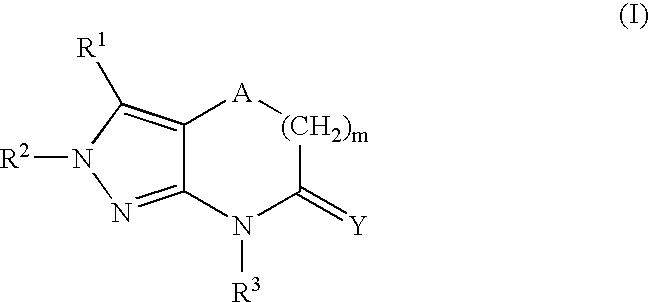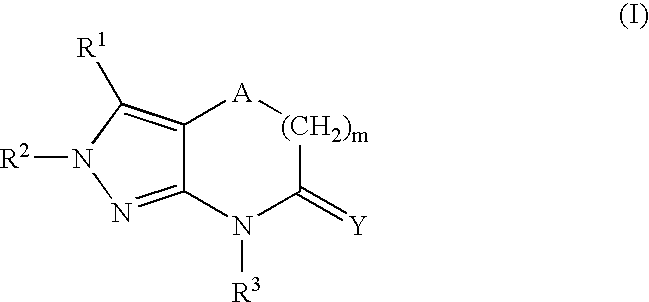Heterocyclic GABAA subtype selective receptor modulators
a selective receptor and heterocyclic gabaa technology, applied in heterocyclic compound active ingredients, drug compositions, biocide, etc., can solve the problems of dependence, sedation, cognitive impairment, ataxia, etc., and achieve the undesirable effect of sedation in an anxiolytic agen
- Summary
- Abstract
- Description
- Claims
- Application Information
AI Technical Summary
Benefits of technology
Problems solved by technology
Method used
Image
Examples
example 1
3-Bromo-7-(2-chloro-4,6-dimethylphenyl)-2-methyl-4,5,6,7-tetrahydro-2H-pyrazolo[3,4-b]pyridine (1-1)
[0156]
Step 1
5-Chloropentanoic acid (2-chloro-4,6-dimethylphenyl)amide
[0157]
[0158] To a solution of 2-chloro-4,6-dimethylaniline (14.7 g) and diisopropylethylamine (18 mL) in 150 mL of THF, was added a solution of 5-chlorovaleryl chloride (12.2 mL) in 75 mL of THF. After the reaction mixture had been allowed to stir at room temperature overnight, it was filtered and the filtrate concentrated on the rotary evaporator. The residue was dissolved in ethyl acetate and washed with 1 M aqueous HCl, saturated aqueous sodium bicarbonate, and brine. The ethyl acetate solution was then dried with magnesium sulfate and concentrated on the rotary evaporator to give a solid which was combined with a 1:1 mixture of hexane and diethyl ether. After this mixture had been stirred for an hour, it was filtered and the collected solids were dried to provide 12.2 g of 5-chloropentanoic acid (2-chloro-4,6...
example 2
3-Bromo-7-(2,4-dichlorophenyl)-2-methyl-4,5,6,7-tetrahydro-2H-pyrazolo[3,4-b]pyridine (1-2)
[0168]
[0169] Compound 1-2 was prepared according the procedure described in Example 1, except that 2-chloro-4,6-dimethylaniline was replaced by 2,4-dichloroaniline in step 1, and step 4 was performed as follows:
1-(2,4-Dichlorophenyl)-2-methylsulfanyl-14,5,6-tetrahydropyridine-3-carboxylic acid methyl ester
[0170]
[0171] To 39.6 ml of a 3M solution ethylmagnesium bromide in ether was added 100 mL of dry tetrahydrofuran under an atmosphere of nitrogen. Then 16.7 mL of diisopropylamine was added dropwise. The reaction mixture was then heated to 80° C. for 1 h. After cooling to room temperature, the mixture was treated with a solution of 6.19 g of 1-(2,4-dichlorophenyl)piperidine-2-thione in 50 mL of dry tetrahydrofuran, heated to 80° C. for 30 min, and cooled again to room temperature. Then the mixture was treated dropwise with 10.0 mL of dimethylcarbonate and heated to 80° C. for 26 h. After co...
example 3
3-Methoxy-7-(4-methoxy-2-methyl-phenyl)-2-methyl-4,5,6,7-tetrahydro-2H-pyrazolo[3,4-b]pyridine (1-14) and 3-methoxy-7-(4-methoxy-2-methyl-phenyl)-1,2-dimethyl-4,5,6,7-tetrahydro-2H-pyrazolo[3,4-b]pyridine sulfuric acid monomethyl ester
[0178]
[0179] 7-(4-methoxy-2-methyl-phenyl)-2-methyl-4,5,6,7-tetrahydro-2H-pyrazolo[3,4-b]pyridin-3-ol (16) was isolated from step 5 of the preparation of 1-7.
[0180] A mixture of 7-(4-methoxy-2-methyl-phenyl)-2-methyl-4,5,6,7-tetrahydro-2H-pyrazolo[3,4-b]pyridin-3-ol (16; 0.150 g, 0.55 mmole) and dimethyl sulfate (0.40 g, 3.2 mmole) under a nitrogen atmosphere was heated at 100° C. for 1 h. The reaction mixture was cooled to room temperature, diluted with ethyl acetate, washed sequentially with saturated sodium bicarbonate and brine, dried over magnesium sulfate, and evaporated to dryness. The residue was purified by preparative thin layer chromatography (methanol / dichloromethane: 3 / 97) which afforded 0.010 g (6% theory) of 1-14 as light brown viscous...
PUM
| Property | Measurement | Unit |
|---|---|---|
| particle size | aaaaa | aaaaa |
| temperature | aaaaa | aaaaa |
| temperature | aaaaa | aaaaa |
Abstract
Description
Claims
Application Information
 Login to View More
Login to View More - R&D
- Intellectual Property
- Life Sciences
- Materials
- Tech Scout
- Unparalleled Data Quality
- Higher Quality Content
- 60% Fewer Hallucinations
Browse by: Latest US Patents, China's latest patents, Technical Efficacy Thesaurus, Application Domain, Technology Topic, Popular Technical Reports.
© 2025 PatSnap. All rights reserved.Legal|Privacy policy|Modern Slavery Act Transparency Statement|Sitemap|About US| Contact US: help@patsnap.com



